University Project Management: Project Close-Out Report
VerifiedAdded on 2023/02/01
|10
|2027
|70
Report
AI Summary
This report provides a detailed analysis of the project close-out phase in project management. It begins by outlining the process of obtaining final customer approval for project deliverables, emphasizing the importance of customer satisfaction. The report then details the criteria necessary for customers to agree that a project has been successfully completed, including clearly defined expectations, deliverables, and mitigation strategies for communication issues. Furthermore, it explores the crucial aspect of documenting lessons learned throughout the project lifecycle, highlighting their role in improving future project management processes. The report also discusses the project team roll-off process, ensuring team members transition smoothly and efficiently after project completion. Finally, it examines the communication strategies required to keep stakeholders informed throughout the project closure phase, covering various communication methods and the importance of delivering relevant information. The report references key project management concepts and principles to provide a comprehensive understanding of project close-out procedures.
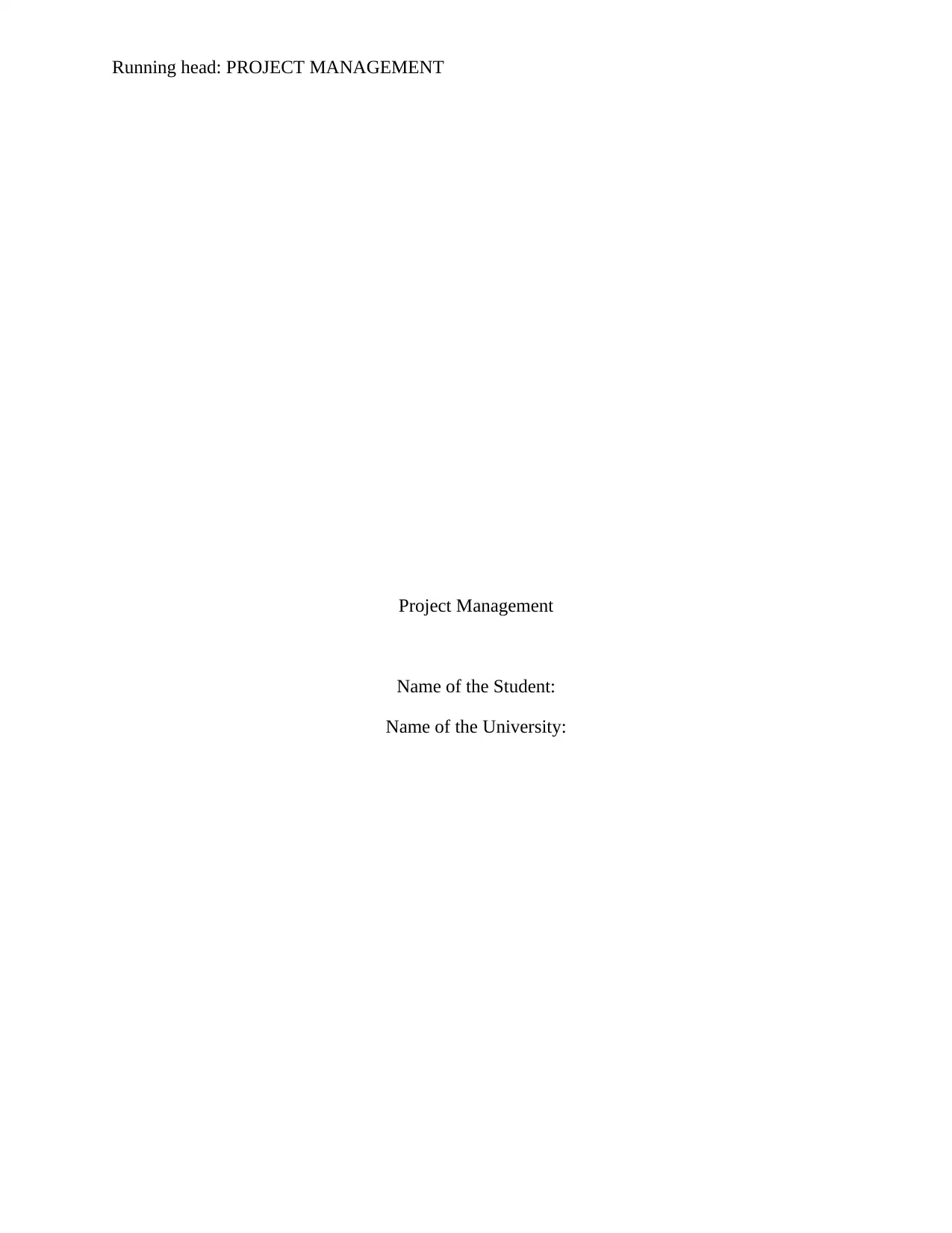
Running head: PROJECT MANAGEMENT
Project Management
Name of the Student:
Name of the University:
Project Management
Name of the Student:
Name of the University:
Paraphrase This Document
Need a fresh take? Get an instant paraphrase of this document with our AI Paraphraser
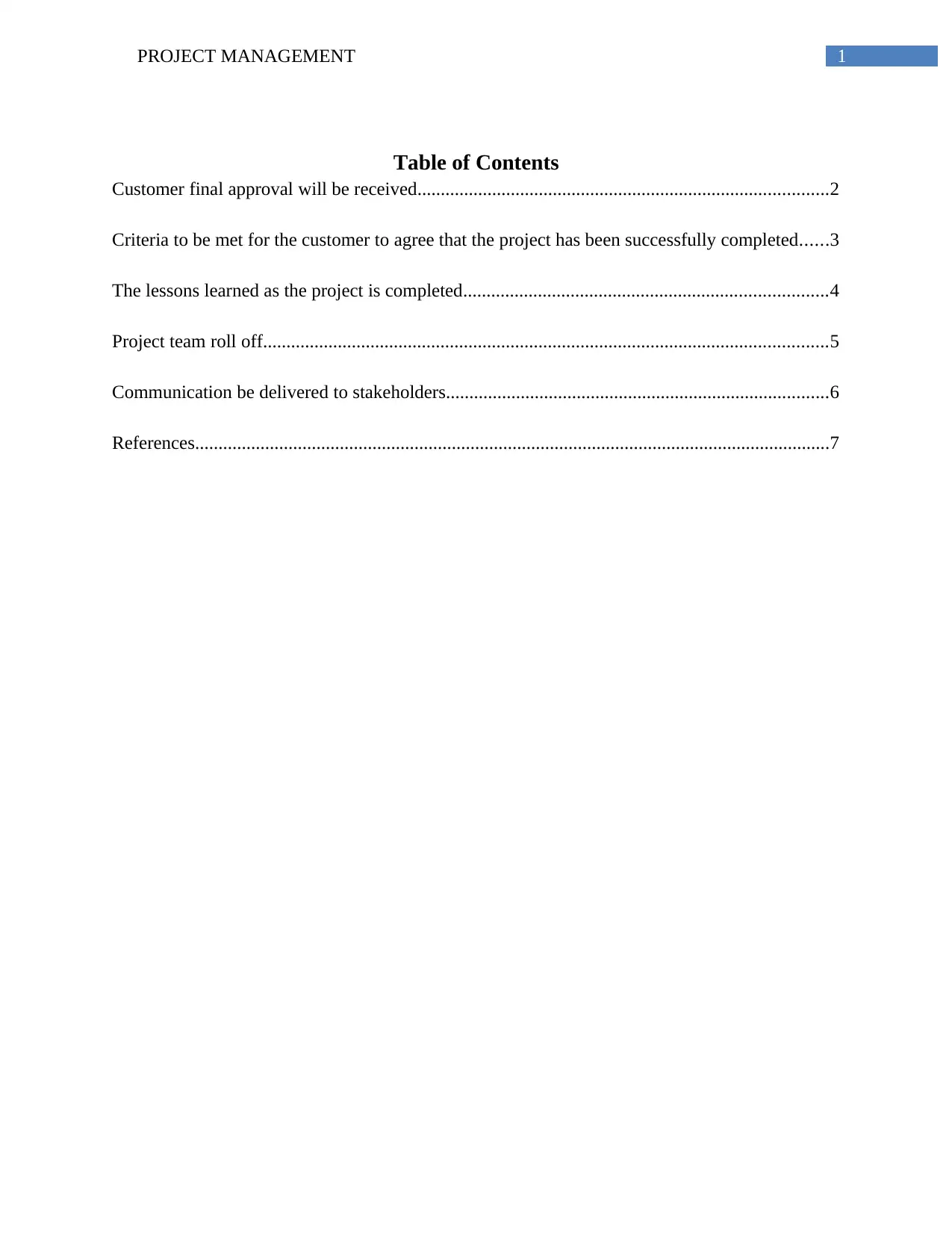
1PROJECT MANAGEMENT
Table of Contents
Customer final approval will be received........................................................................................2
Criteria to be met for the customer to agree that the project has been successfully completed......3
The lessons learned as the project is completed..............................................................................4
Project team roll off.........................................................................................................................5
Communication be delivered to stakeholders..................................................................................6
References........................................................................................................................................7
Table of Contents
Customer final approval will be received........................................................................................2
Criteria to be met for the customer to agree that the project has been successfully completed......3
The lessons learned as the project is completed..............................................................................4
Project team roll off.........................................................................................................................5
Communication be delivered to stakeholders..................................................................................6
References........................................................................................................................................7
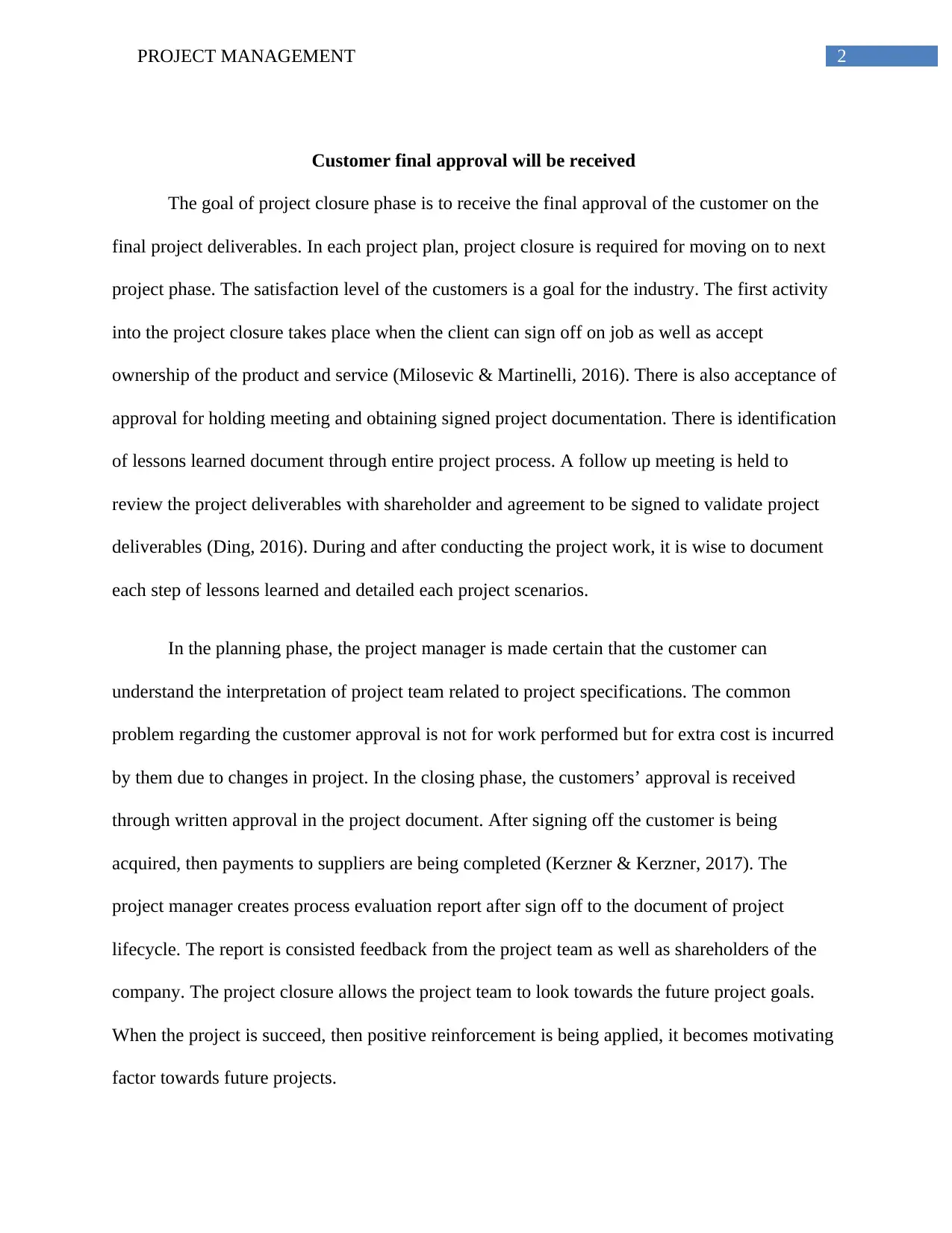
2PROJECT MANAGEMENT
Customer final approval will be received
The goal of project closure phase is to receive the final approval of the customer on the
final project deliverables. In each project plan, project closure is required for moving on to next
project phase. The satisfaction level of the customers is a goal for the industry. The first activity
into the project closure takes place when the client can sign off on job as well as accept
ownership of the product and service (Milosevic & Martinelli, 2016). There is also acceptance of
approval for holding meeting and obtaining signed project documentation. There is identification
of lessons learned document through entire project process. A follow up meeting is held to
review the project deliverables with shareholder and agreement to be signed to validate project
deliverables (Ding, 2016). During and after conducting the project work, it is wise to document
each step of lessons learned and detailed each project scenarios.
In the planning phase, the project manager is made certain that the customer can
understand the interpretation of project team related to project specifications. The common
problem regarding the customer approval is not for work performed but for extra cost is incurred
by them due to changes in project. In the closing phase, the customers’ approval is received
through written approval in the project document. After signing off the customer is being
acquired, then payments to suppliers are being completed (Kerzner & Kerzner, 2017). The
project manager creates process evaluation report after sign off to the document of project
lifecycle. The report is consisted feedback from the project team as well as shareholders of the
company. The project closure allows the project team to look towards the future project goals.
When the project is succeed, then positive reinforcement is being applied, it becomes motivating
factor towards future projects.
Customer final approval will be received
The goal of project closure phase is to receive the final approval of the customer on the
final project deliverables. In each project plan, project closure is required for moving on to next
project phase. The satisfaction level of the customers is a goal for the industry. The first activity
into the project closure takes place when the client can sign off on job as well as accept
ownership of the product and service (Milosevic & Martinelli, 2016). There is also acceptance of
approval for holding meeting and obtaining signed project documentation. There is identification
of lessons learned document through entire project process. A follow up meeting is held to
review the project deliverables with shareholder and agreement to be signed to validate project
deliverables (Ding, 2016). During and after conducting the project work, it is wise to document
each step of lessons learned and detailed each project scenarios.
In the planning phase, the project manager is made certain that the customer can
understand the interpretation of project team related to project specifications. The common
problem regarding the customer approval is not for work performed but for extra cost is incurred
by them due to changes in project. In the closing phase, the customers’ approval is received
through written approval in the project document. After signing off the customer is being
acquired, then payments to suppliers are being completed (Kerzner & Kerzner, 2017). The
project manager creates process evaluation report after sign off to the document of project
lifecycle. The report is consisted feedback from the project team as well as shareholders of the
company. The project closure allows the project team to look towards the future project goals.
When the project is succeed, then positive reinforcement is being applied, it becomes motivating
factor towards future projects.
⊘ This is a preview!⊘
Do you want full access?
Subscribe today to unlock all pages.

Trusted by 1+ million students worldwide
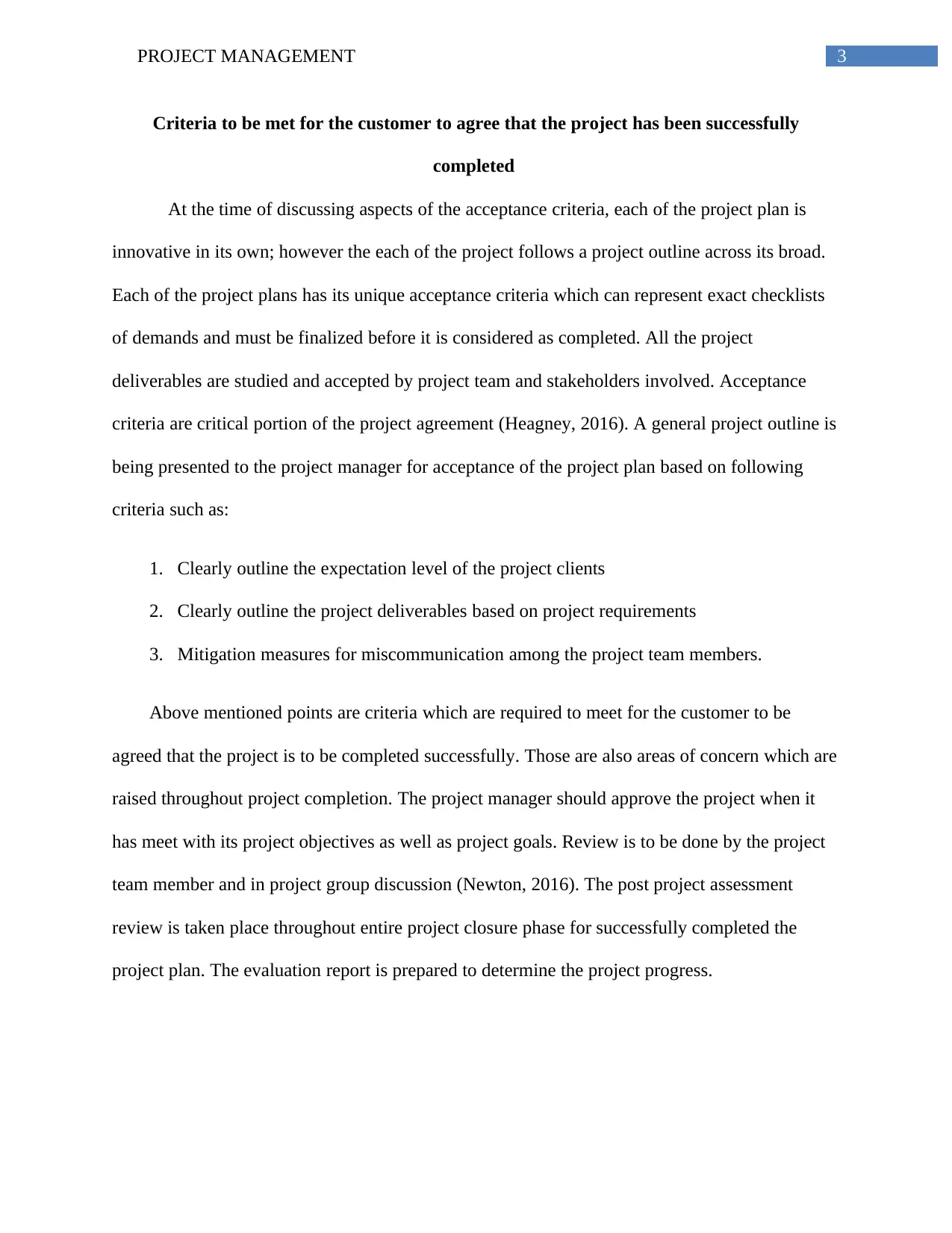
3PROJECT MANAGEMENT
Criteria to be met for the customer to agree that the project has been successfully
completed
At the time of discussing aspects of the acceptance criteria, each of the project plan is
innovative in its own; however the each of the project follows a project outline across its broad.
Each of the project plans has its unique acceptance criteria which can represent exact checklists
of demands and must be finalized before it is considered as completed. All the project
deliverables are studied and accepted by project team and stakeholders involved. Acceptance
criteria are critical portion of the project agreement (Heagney, 2016). A general project outline is
being presented to the project manager for acceptance of the project plan based on following
criteria such as:
1. Clearly outline the expectation level of the project clients
2. Clearly outline the project deliverables based on project requirements
3. Mitigation measures for miscommunication among the project team members.
Above mentioned points are criteria which are required to meet for the customer to be
agreed that the project is to be completed successfully. Those are also areas of concern which are
raised throughout project completion. The project manager should approve the project when it
has meet with its project objectives as well as project goals. Review is to be done by the project
team member and in project group discussion (Newton, 2016). The post project assessment
review is taken place throughout entire project closure phase for successfully completed the
project plan. The evaluation report is prepared to determine the project progress.
Criteria to be met for the customer to agree that the project has been successfully
completed
At the time of discussing aspects of the acceptance criteria, each of the project plan is
innovative in its own; however the each of the project follows a project outline across its broad.
Each of the project plans has its unique acceptance criteria which can represent exact checklists
of demands and must be finalized before it is considered as completed. All the project
deliverables are studied and accepted by project team and stakeholders involved. Acceptance
criteria are critical portion of the project agreement (Heagney, 2016). A general project outline is
being presented to the project manager for acceptance of the project plan based on following
criteria such as:
1. Clearly outline the expectation level of the project clients
2. Clearly outline the project deliverables based on project requirements
3. Mitigation measures for miscommunication among the project team members.
Above mentioned points are criteria which are required to meet for the customer to be
agreed that the project is to be completed successfully. Those are also areas of concern which are
raised throughout project completion. The project manager should approve the project when it
has meet with its project objectives as well as project goals. Review is to be done by the project
team member and in project group discussion (Newton, 2016). The post project assessment
review is taken place throughout entire project closure phase for successfully completed the
project plan. The evaluation report is prepared to determine the project progress.
Paraphrase This Document
Need a fresh take? Get an instant paraphrase of this document with our AI Paraphraser
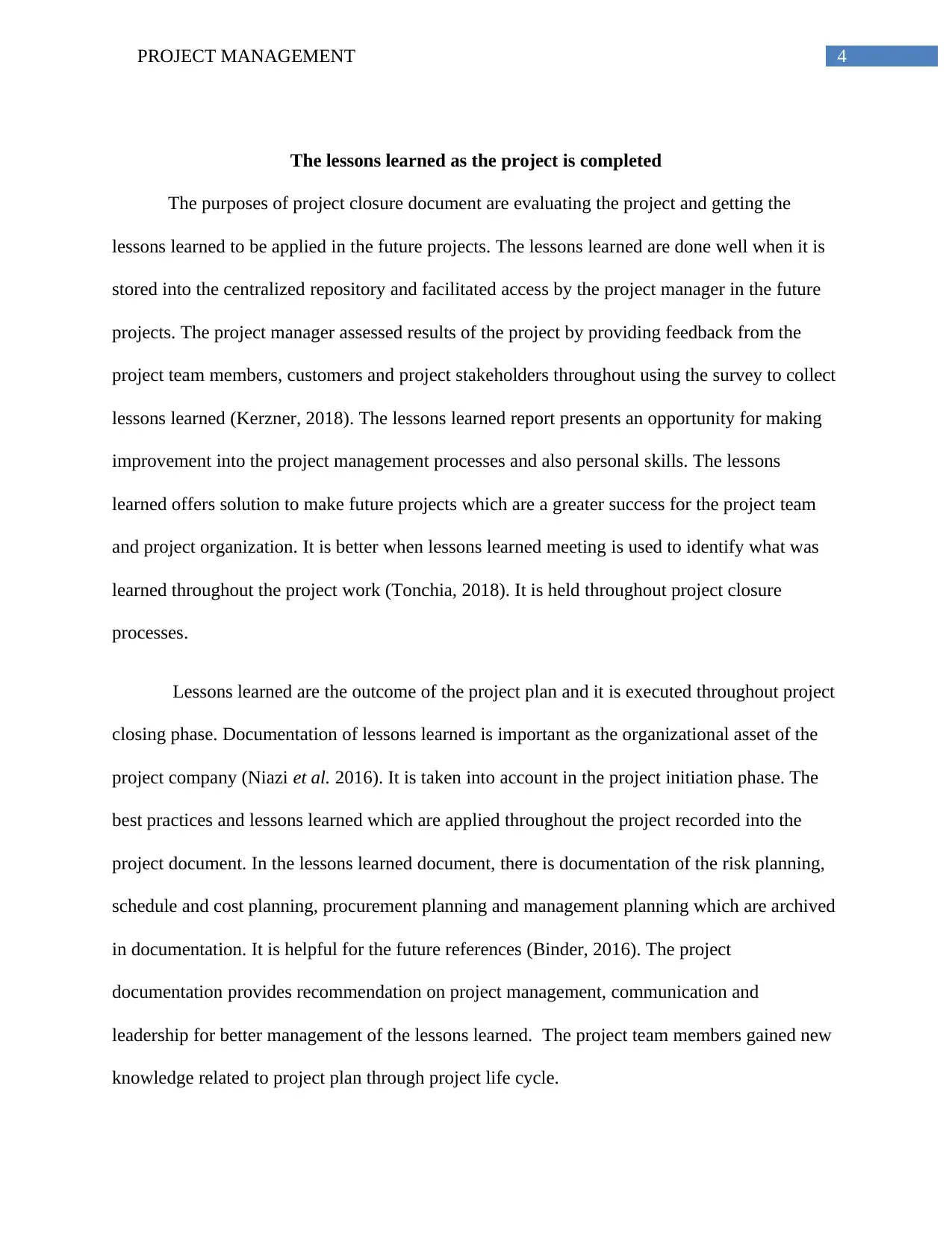
4PROJECT MANAGEMENT
The lessons learned as the project is completed
The purposes of project closure document are evaluating the project and getting the
lessons learned to be applied in the future projects. The lessons learned are done well when it is
stored into the centralized repository and facilitated access by the project manager in the future
projects. The project manager assessed results of the project by providing feedback from the
project team members, customers and project stakeholders throughout using the survey to collect
lessons learned (Kerzner, 2018). The lessons learned report presents an opportunity for making
improvement into the project management processes and also personal skills. The lessons
learned offers solution to make future projects which are a greater success for the project team
and project organization. It is better when lessons learned meeting is used to identify what was
learned throughout the project work (Tonchia, 2018). It is held throughout project closure
processes.
Lessons learned are the outcome of the project plan and it is executed throughout project
closing phase. Documentation of lessons learned is important as the organizational asset of the
project company (Niazi et al. 2016). It is taken into account in the project initiation phase. The
best practices and lessons learned which are applied throughout the project recorded into the
project document. In the lessons learned document, there is documentation of the risk planning,
schedule and cost planning, procurement planning and management planning which are archived
in documentation. It is helpful for the future references (Binder, 2016). The project
documentation provides recommendation on project management, communication and
leadership for better management of the lessons learned. The project team members gained new
knowledge related to project plan through project life cycle.
The lessons learned as the project is completed
The purposes of project closure document are evaluating the project and getting the
lessons learned to be applied in the future projects. The lessons learned are done well when it is
stored into the centralized repository and facilitated access by the project manager in the future
projects. The project manager assessed results of the project by providing feedback from the
project team members, customers and project stakeholders throughout using the survey to collect
lessons learned (Kerzner, 2018). The lessons learned report presents an opportunity for making
improvement into the project management processes and also personal skills. The lessons
learned offers solution to make future projects which are a greater success for the project team
and project organization. It is better when lessons learned meeting is used to identify what was
learned throughout the project work (Tonchia, 2018). It is held throughout project closure
processes.
Lessons learned are the outcome of the project plan and it is executed throughout project
closing phase. Documentation of lessons learned is important as the organizational asset of the
project company (Niazi et al. 2016). It is taken into account in the project initiation phase. The
best practices and lessons learned which are applied throughout the project recorded into the
project document. In the lessons learned document, there is documentation of the risk planning,
schedule and cost planning, procurement planning and management planning which are archived
in documentation. It is helpful for the future references (Binder, 2016). The project
documentation provides recommendation on project management, communication and
leadership for better management of the lessons learned. The project team members gained new
knowledge related to project plan through project life cycle.

5PROJECT MANAGEMENT
⊘ This is a preview!⊘
Do you want full access?
Subscribe today to unlock all pages.

Trusted by 1+ million students worldwide
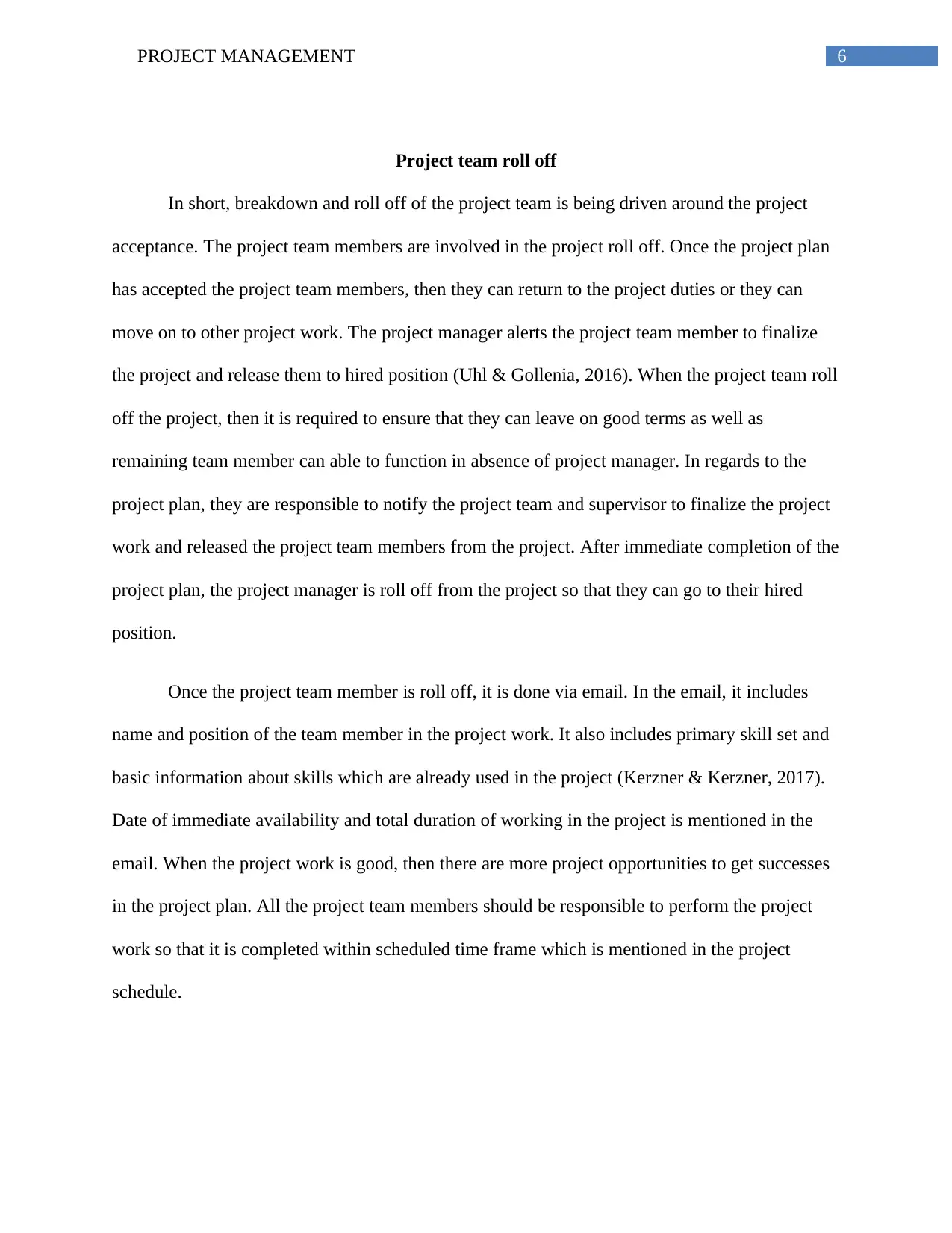
6PROJECT MANAGEMENT
Project team roll off
In short, breakdown and roll off of the project team is being driven around the project
acceptance. The project team members are involved in the project roll off. Once the project plan
has accepted the project team members, then they can return to the project duties or they can
move on to other project work. The project manager alerts the project team member to finalize
the project and release them to hired position (Uhl & Gollenia, 2016). When the project team roll
off the project, then it is required to ensure that they can leave on good terms as well as
remaining team member can able to function in absence of project manager. In regards to the
project plan, they are responsible to notify the project team and supervisor to finalize the project
work and released the project team members from the project. After immediate completion of the
project plan, the project manager is roll off from the project so that they can go to their hired
position.
Once the project team member is roll off, it is done via email. In the email, it includes
name and position of the team member in the project work. It also includes primary skill set and
basic information about skills which are already used in the project (Kerzner & Kerzner, 2017).
Date of immediate availability and total duration of working in the project is mentioned in the
email. When the project work is good, then there are more project opportunities to get successes
in the project plan. All the project team members should be responsible to perform the project
work so that it is completed within scheduled time frame which is mentioned in the project
schedule.
Project team roll off
In short, breakdown and roll off of the project team is being driven around the project
acceptance. The project team members are involved in the project roll off. Once the project plan
has accepted the project team members, then they can return to the project duties or they can
move on to other project work. The project manager alerts the project team member to finalize
the project and release them to hired position (Uhl & Gollenia, 2016). When the project team roll
off the project, then it is required to ensure that they can leave on good terms as well as
remaining team member can able to function in absence of project manager. In regards to the
project plan, they are responsible to notify the project team and supervisor to finalize the project
work and released the project team members from the project. After immediate completion of the
project plan, the project manager is roll off from the project so that they can go to their hired
position.
Once the project team member is roll off, it is done via email. In the email, it includes
name and position of the team member in the project work. It also includes primary skill set and
basic information about skills which are already used in the project (Kerzner & Kerzner, 2017).
Date of immediate availability and total duration of working in the project is mentioned in the
email. When the project work is good, then there are more project opportunities to get successes
in the project plan. All the project team members should be responsible to perform the project
work so that it is completed within scheduled time frame which is mentioned in the project
schedule.
Paraphrase This Document
Need a fresh take? Get an instant paraphrase of this document with our AI Paraphraser
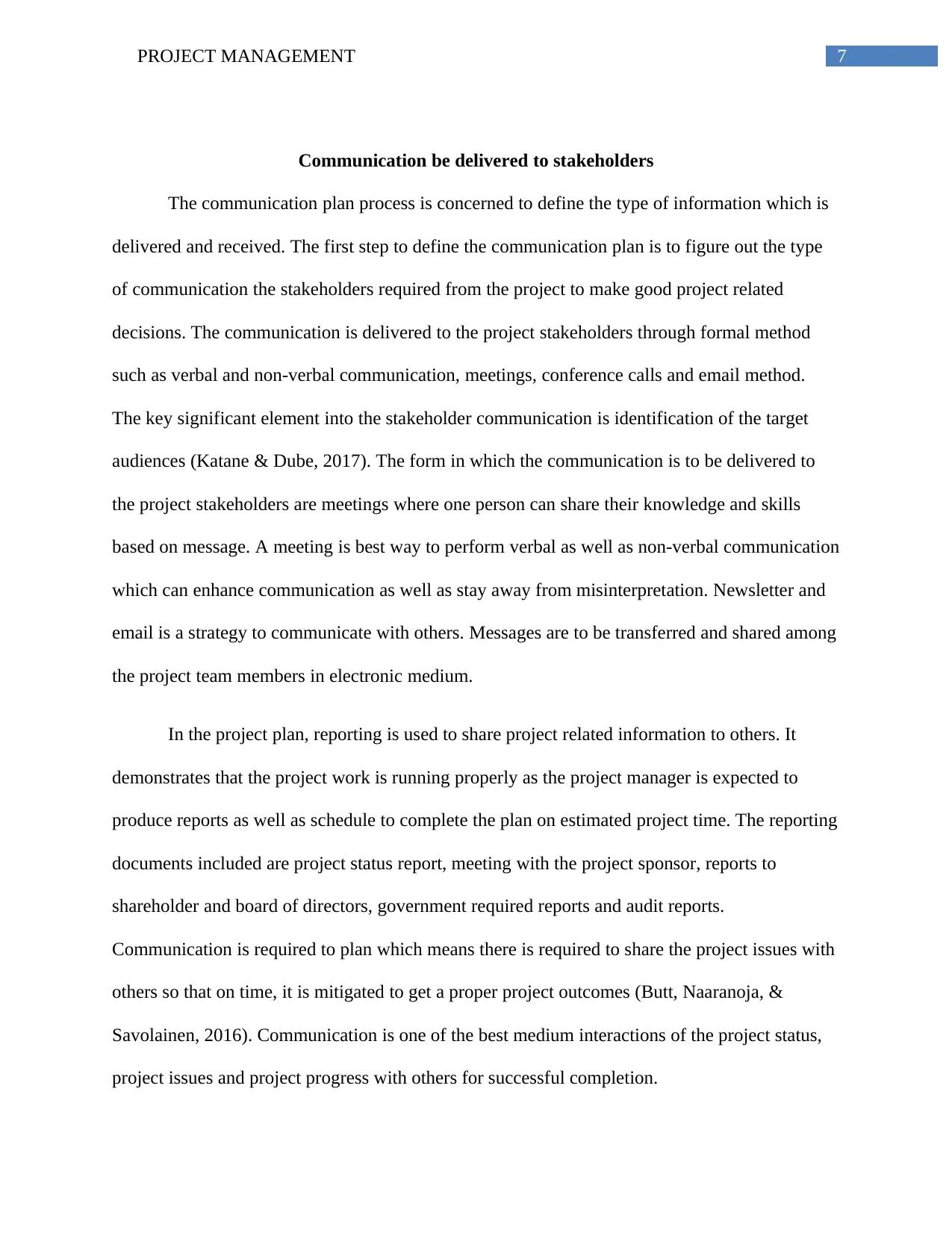
7PROJECT MANAGEMENT
Communication be delivered to stakeholders
The communication plan process is concerned to define the type of information which is
delivered and received. The first step to define the communication plan is to figure out the type
of communication the stakeholders required from the project to make good project related
decisions. The communication is delivered to the project stakeholders through formal method
such as verbal and non-verbal communication, meetings, conference calls and email method.
The key significant element into the stakeholder communication is identification of the target
audiences (Katane & Dube, 2017). The form in which the communication is to be delivered to
the project stakeholders are meetings where one person can share their knowledge and skills
based on message. A meeting is best way to perform verbal as well as non-verbal communication
which can enhance communication as well as stay away from misinterpretation. Newsletter and
email is a strategy to communicate with others. Messages are to be transferred and shared among
the project team members in electronic medium.
In the project plan, reporting is used to share project related information to others. It
demonstrates that the project work is running properly as the project manager is expected to
produce reports as well as schedule to complete the plan on estimated project time. The reporting
documents included are project status report, meeting with the project sponsor, reports to
shareholder and board of directors, government required reports and audit reports.
Communication is required to plan which means there is required to share the project issues with
others so that on time, it is mitigated to get a proper project outcomes (Butt, Naaranoja, &
Savolainen, 2016). Communication is one of the best medium interactions of the project status,
project issues and project progress with others for successful completion.
Communication be delivered to stakeholders
The communication plan process is concerned to define the type of information which is
delivered and received. The first step to define the communication plan is to figure out the type
of communication the stakeholders required from the project to make good project related
decisions. The communication is delivered to the project stakeholders through formal method
such as verbal and non-verbal communication, meetings, conference calls and email method.
The key significant element into the stakeholder communication is identification of the target
audiences (Katane & Dube, 2017). The form in which the communication is to be delivered to
the project stakeholders are meetings where one person can share their knowledge and skills
based on message. A meeting is best way to perform verbal as well as non-verbal communication
which can enhance communication as well as stay away from misinterpretation. Newsletter and
email is a strategy to communicate with others. Messages are to be transferred and shared among
the project team members in electronic medium.
In the project plan, reporting is used to share project related information to others. It
demonstrates that the project work is running properly as the project manager is expected to
produce reports as well as schedule to complete the plan on estimated project time. The reporting
documents included are project status report, meeting with the project sponsor, reports to
shareholder and board of directors, government required reports and audit reports.
Communication is required to plan which means there is required to share the project issues with
others so that on time, it is mitigated to get a proper project outcomes (Butt, Naaranoja, &
Savolainen, 2016). Communication is one of the best medium interactions of the project status,
project issues and project progress with others for successful completion.
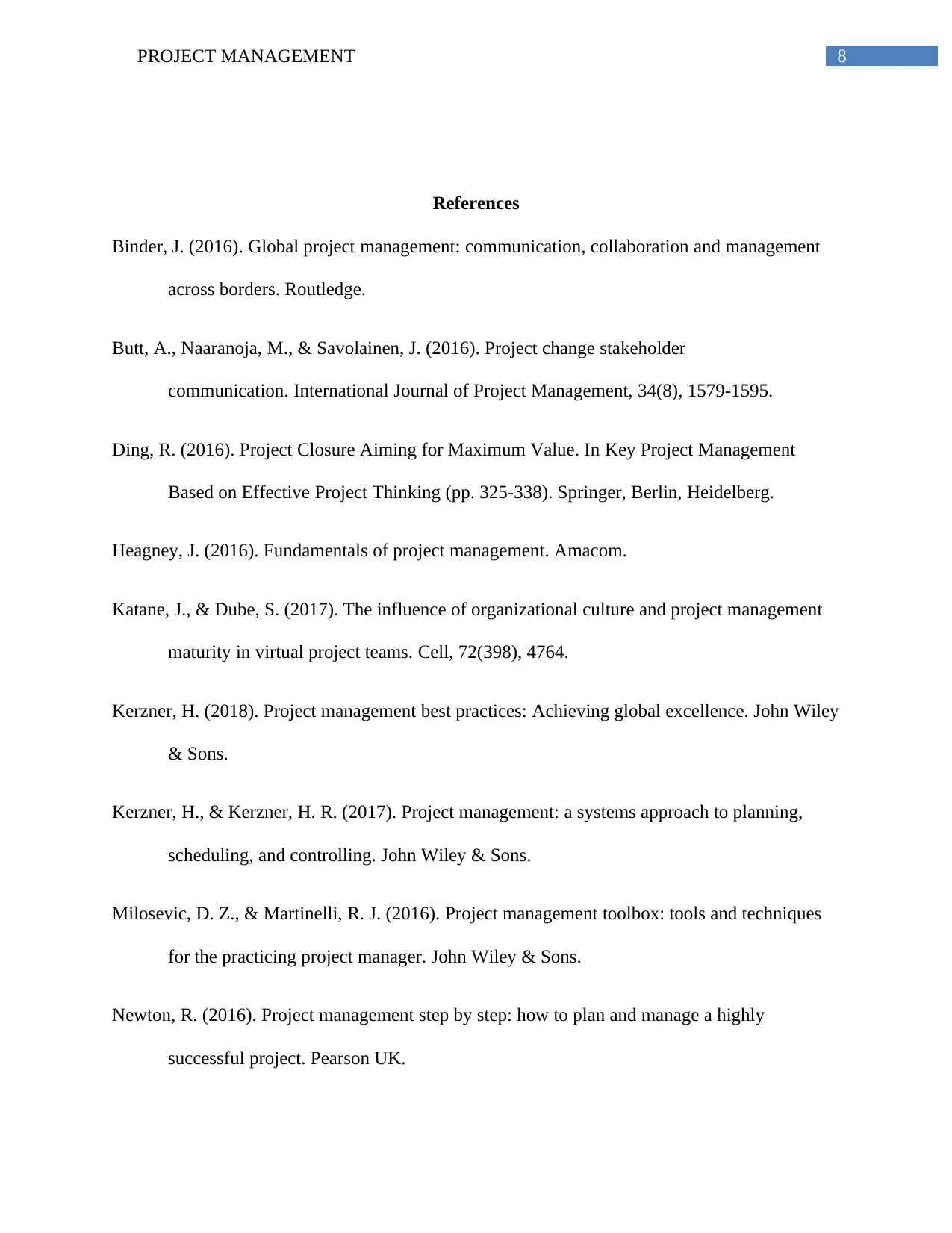
8PROJECT MANAGEMENT
References
Binder, J. (2016). Global project management: communication, collaboration and management
across borders. Routledge.
Butt, A., Naaranoja, M., & Savolainen, J. (2016). Project change stakeholder
communication. International Journal of Project Management, 34(8), 1579-1595.
Ding, R. (2016). Project Closure Aiming for Maximum Value. In Key Project Management
Based on Effective Project Thinking (pp. 325-338). Springer, Berlin, Heidelberg.
Heagney, J. (2016). Fundamentals of project management. Amacom.
Katane, J., & Dube, S. (2017). The influence of organizational culture and project management
maturity in virtual project teams. Cell, 72(398), 4764.
Kerzner, H. (2018). Project management best practices: Achieving global excellence. John Wiley
& Sons.
Kerzner, H., & Kerzner, H. R. (2017). Project management: a systems approach to planning,
scheduling, and controlling. John Wiley & Sons.
Milosevic, D. Z., & Martinelli, R. J. (2016). Project management toolbox: tools and techniques
for the practicing project manager. John Wiley & Sons.
Newton, R. (2016). Project management step by step: how to plan and manage a highly
successful project. Pearson UK.
References
Binder, J. (2016). Global project management: communication, collaboration and management
across borders. Routledge.
Butt, A., Naaranoja, M., & Savolainen, J. (2016). Project change stakeholder
communication. International Journal of Project Management, 34(8), 1579-1595.
Ding, R. (2016). Project Closure Aiming for Maximum Value. In Key Project Management
Based on Effective Project Thinking (pp. 325-338). Springer, Berlin, Heidelberg.
Heagney, J. (2016). Fundamentals of project management. Amacom.
Katane, J., & Dube, S. (2017). The influence of organizational culture and project management
maturity in virtual project teams. Cell, 72(398), 4764.
Kerzner, H. (2018). Project management best practices: Achieving global excellence. John Wiley
& Sons.
Kerzner, H., & Kerzner, H. R. (2017). Project management: a systems approach to planning,
scheduling, and controlling. John Wiley & Sons.
Milosevic, D. Z., & Martinelli, R. J. (2016). Project management toolbox: tools and techniques
for the practicing project manager. John Wiley & Sons.
Newton, R. (2016). Project management step by step: how to plan and manage a highly
successful project. Pearson UK.
⊘ This is a preview!⊘
Do you want full access?
Subscribe today to unlock all pages.

Trusted by 1+ million students worldwide
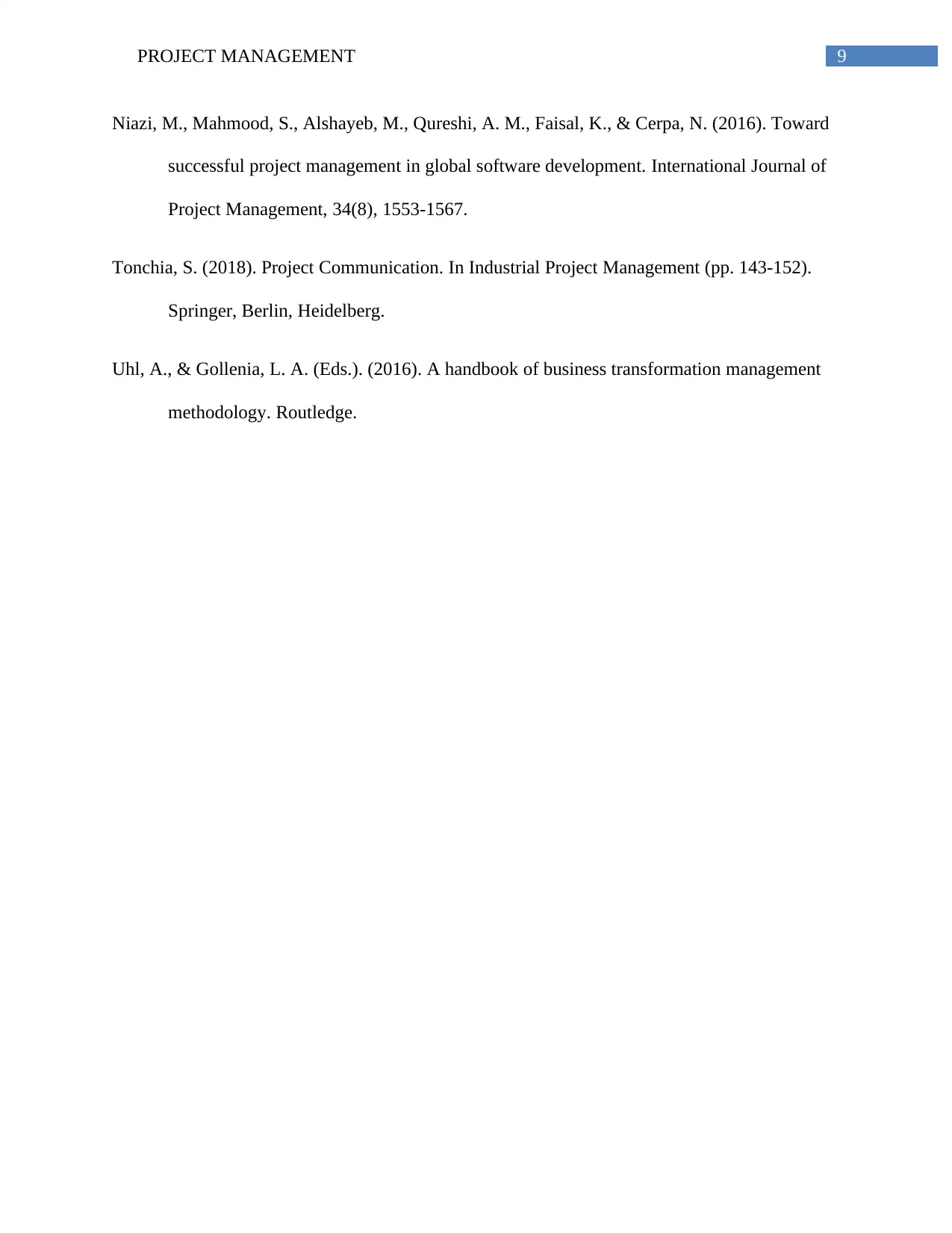
9PROJECT MANAGEMENT
Niazi, M., Mahmood, S., Alshayeb, M., Qureshi, A. M., Faisal, K., & Cerpa, N. (2016). Toward
successful project management in global software development. International Journal of
Project Management, 34(8), 1553-1567.
Tonchia, S. (2018). Project Communication. In Industrial Project Management (pp. 143-152).
Springer, Berlin, Heidelberg.
Uhl, A., & Gollenia, L. A. (Eds.). (2016). A handbook of business transformation management
methodology. Routledge.
Niazi, M., Mahmood, S., Alshayeb, M., Qureshi, A. M., Faisal, K., & Cerpa, N. (2016). Toward
successful project management in global software development. International Journal of
Project Management, 34(8), 1553-1567.
Tonchia, S. (2018). Project Communication. In Industrial Project Management (pp. 143-152).
Springer, Berlin, Heidelberg.
Uhl, A., & Gollenia, L. A. (Eds.). (2016). A handbook of business transformation management
methodology. Routledge.
1 out of 10
Related Documents
Your All-in-One AI-Powered Toolkit for Academic Success.
+13062052269
info@desklib.com
Available 24*7 on WhatsApp / Email
![[object Object]](/_next/static/media/star-bottom.7253800d.svg)
Unlock your academic potential
Copyright © 2020–2025 A2Z Services. All Rights Reserved. Developed and managed by ZUCOL.





